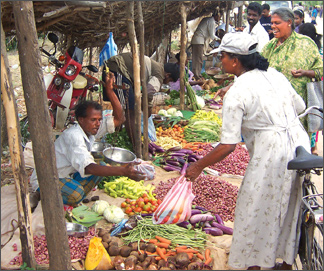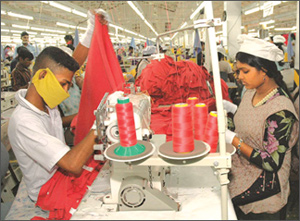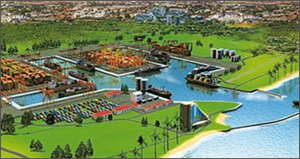Sri Lanka can smile - most contented Asians
by Shirajiv SIRIMANE

Jaffna, now ... land of opportunity |

A BOI company in Katunayake |

The would be Hambantota port |

Tourists enjoying the sandy beaches of the South. |
Sri Lanka is a land of smiles as the people, whatever their problems,
always make it a point to smile. And Sri Lankans can now smile widely
for a reason as Sri Lanka has topped an Asian list of people most
contended with their lives.
Sri Lanka topped the list with 93 per cent while Singapore ranked
ninth on the satisfaction scale out of 16 countries surveyed in an Asia
Pacific consumer study by the advertising firm Grey Group.
But Singaporeans' outlook for the future was more pessimistic than
that of most people from neighbouring countries. Asked if the future
would be better than the past China and Sri Lanka tied for being the
most optimistic, with 94 per cent each while only 65 per cent of
Singaporeans agreed.
Sri Lanka, then called Ceylon, was a self-sufficient country with a
rich culture and a highly advanced irrigation system that even baffles
today's scientists. However, this life style of the proud Ceylonese was
forced to change from 1505 when Portuguese and Dutch and subsequently
the British invaded it. Since gaining independence, the country suffered
two major communal backlashes in 1956 inspired by the Sinhlala only bill
and in 1983 by the LTTE killing of 13 solders in Jaffna.
Sri Lanka was further put back by two Southern insurrections in 1971
and 1989 and subsequently by the tsunami on Christmas Eve in 2004.
However, people still smiled.
The violence that started with the killing of Jaffna Mayor, Alfred
Duraiappa, not only crippled the economy, but also slowly and surely
dimmed the smiles of the people of Sri Lanka of all communities for
nearly three decades.
One needed a leader with charisma, and President Mahinda Rajapaksa
took the challenge of crushing the world's deadliest terrorist
organization, which boasted of several world's firsts such as suicide
carders. It was the only such organization to have an air wing and
submarines.
Unlike his successors, President Rajapaksa did not take the warpath,
but adopted a humanitarian approach to wipe out the terrorist
organization once again putting back the smiles on the faces of the
people of Sri Lanka.
One key factor that the government did not forget while the war was
going on was to keep a tab on the economy. It launched several
infrastructure development projects that some governments would not have
launched even if there was no war.
Some of the key projects that were launched during the height of the
war were the Hambantota Port Development Project; Kotmale, Norochchole,
Uma Oya, Kerawalapitiya and Moragahakanda Power Supply and Irrigation
Projects. Colombo-Matara and Colombo-Katunayake are the first two-toll
highways ever to be constructed in Sri Lanka. The main objective of the
Colombo-Matara highway project is to assist the development of the
economy of Southern Province by encouraging growth in industries,
tourism, fisheries and agriculture.
The principal product of the project is Sri Lanka's first access
controlled expressway, connecting Kottawa and Colombo suburbs to Matara
in the Southern Province with an access road from the highway to Galle
which is the capital of Southern Province. Access to the expressway is
only through eleven interchanges which are located at places where the
expressway crosses major roads/highways.
Meanwhile, the first stage of the much awaited and long overdue
Colombo - Katunayake Expressway (CKE) will be completed by 2012 and
would be operated as a toll expressway.
The total length of the expressway would be around 25 kilometres
starting from the New Kelani Bridge (NKB) and ending at the Airport
Access Road (Canada Friendship Road) at Katunayake.
The prime objective of the project is to create a high mobility link
between the city of Colombo and Katunayake International Airport and a
motorist would be able to travel to the airport from NKB in just 20
minutes. Currently, the travel time is around 90 minutes from the
existing Peliyagoda-Puttalam (A3) Road.
The extension of the rail network to both North and the South will
bring unprecedented economic benefits to the country. The government's
Eastern development programme under the `Neganahira Navodaya'
development drive has invested almost Rs.75 billion into various sectors
in the East so far, and a further Rs.121 billion by 2010.
It is reported that paddy production increased to 717,869 MT at
growth rate of 4.1% and maize output increased to 17,655 MT whilst fruit
villages have increased to almost 26 with 511 beneficiaries and 48,275
plants been issued as per available data under the program.
The country's foreign exchange reserves which were at a low ebb in
March, had now also increased by almost 40 per cent. This is a record
increase.
Another benchmark was the Stock Exchange which too has gained second
place among the fastest growing share markets in the world.
Foreign direct investments are another area to impress. Since the war
ended, there is renewed confidence in the Sri Lankan economy and the
Board of Investment (BOI) expects this trend to lead to increased levels
of FDI inflows. The BOI's forecast is that Sri Lanka will attract FDI
worth US$ 1 billion in 2009 and US$ 1.2 billion in 2010. Investors are
of course attracted to a predictable and stable business environment
that now exists, since the war has ended.
"We are also targeting the Sri Lankan Diaspora as Sri Lanka is now
not restricted to the confines of this island. There are over a million
of our nationals overseas and many of them may wish to invest in Sri
Lanka. There is especially a large Tamil community overseas and to
facilitate their investments in the island, the BOI has also opened an
office in Jaffna," said Chairman Director General of the BOI Dhammika
Perera.
"International investors say that Sri Lanka has a high growth
potential with the return of peace." With the dawn of peace, one of the
first sectors to make an impact was tourism with Sri Lanka's tourist
arrivals jumping by 28% in July from a year ago, its second straight
rise since May last year.
This follows an 8% rise in June alone. According to Sri Lanka Tourism
officials, the leap is attributed to the resolution of the long drawn
ethnic conflict in the island.
The rapid growth in the Middle East market has recorded an
unprecedented 103.7% when compared to July 2008. This is the first time
a 3-digit growth figure has been registered in the history of Sri Lanka
tourism.
Chairman of the Sri Lanka Tourism and Promotions Bureau, Bernard
Goonetilleke said, "This is indeed a significant moment for us. To be
moving forward positively at such a rapid pace is truly remarkable."
South Asia, which registered growth figures of 39% when compared to
the same period last year, is the second highest growth region led by
India recording a 45% growth this month while East Asia, with a
substantial 31% growth is the third highest growth region for in bound
tourism in Sri Lanka for July 2009.
One of the key factors people feel in their hearts is inflation, and
this too is being addressed with indicators showing a decline.
With a massive land exodus due to the ending of the war it would
create development opportunities for both the public and the private
sector. Many have predicted that this would lead to self-sufficiency in
the agricultural sector in just two years.
|

